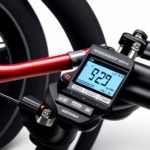Not sure about the condition of your electric bike’s battery? No problem, I’ve got you covered.
In this article, I’ll guide you through the process of checking your electric bike battery step by step. From locating the battery compartment to testing its performance, I’ll provide you with detailed instructions to ensure your battery is in top condition.
So let’s dive in and learn how to keep your electric bike running smoothly and efficiently.
Key Takeaways
- Inspect the battery compartment for any damage or corrosion.
- Use a multimeter or battery tester to check the battery charge level.
- Follow the manufacturer’s guidelines for charging and maintaining the battery.
- Seek professional assistance for complex battery issues and consider warranty coverage.
Locate the Battery Compartment
To check the electric bike battery, first, locate the battery compartment. This is where you will find the battery that powers your bike. The battery compartment is usually located near the rear wheel or on the frame of the bike. It may be covered by a panel or a removable cover.
When troubleshooting battery issues, the first step is to access the battery compartment. To do this, start by turning off the power to the bike. This will ensure your safety and prevent any accidental electrical shocks. Once the power is off, locate the battery compartment and remove any panels or covers that may be in the way.
Once you have access to the battery compartment, visually inspect the battery for any signs of damage or corrosion. Look for any loose connections or frayed wires. Make sure that the battery is securely fastened in place and that all the connections are tight.
Turn off the Power
First, make sure you’ve switched off the power. It is crucial to take this step before performing any maintenance or inspection on an electric bike battery. Turning off the power eliminates the risk of electric shock and ensures your safety.
To turn off the power, locate the power switch on your electric bike. It is usually located near the battery or on the handlebars. Once you’ve located the switch, simply press or toggle it to the off position.
It is important to follow battery safety precautions when handling an electric bike battery. Always wear protective gloves and goggles to prevent any potential accidents. Additionally, avoid exposing the battery to extreme temperatures or excess moisture.
Now that the power is off, it’s time to remove the battery from the bike. This is a crucial step in inspecting the battery and ensuring its proper functioning.
Remove the Battery from the Bike
Once the power is off, it’s time to take the battery out of the bike. Removing the battery from an electric bike may seem like a simple task, but it’s important to do it correctly to avoid any damage to the battery or the bike itself.
Here are some tips for safely removing the battery:
-
Locate the battery: The battery is usually located on the downtube or the rear rack of the bike. Refer to the manufacturer’s manual if you’re unsure.
-
Disconnect the cables: Before removing the battery, make sure to disconnect any cables or connectors that are attached to it. This will prevent any accidental electrical discharge.
-
Remove the battery: Once the cables are disconnected, gently slide the battery out of its mounting bracket or holder. Be careful not to drop or damage the battery during this process.
Now that the battery is removed, it’s important to store it properly to prolong its lifespan. Here are some battery storage methods to consider:
- Keep the battery in a cool, dry place.
- Store the battery at around 50% charge.
- Avoid storing the battery in extreme temperatures.
With the battery safely removed and stored, the next step is to inspect it for any signs of damage or wear.
Inspect the Battery for Damage
Now, take a close look at the battery to see if there are any signs of damage or wear. Inspecting the battery for damage is crucial to ensure its proper functioning and safety.
Begin by visually examining the battery casing for any cracks, dents, or bulges. These can indicate internal damage or potential leaks. Pay close attention to the terminals as well, checking for any corrosion or loose connections. Corrosion can hinder the battery’s ability to deliver power effectively.
Additionally, inspect the wiring and connectors for any fraying or exposed wires, as this can pose a safety risk. If you notice any of these issues during the inspection, it is essential to replace the battery promptly to prevent further damage or potential accidents.
By ensuring that your battery is in good condition, you can optimize its performance and prolong its lifespan.
Now, let’s move on to the next step and check the battery charge level.
Check the Battery Charge Level
To determine the battery charge level, you’ll want to use a multimeter or a battery tester. These tools are essential for accurately measuring the voltage of your electric bike battery.
Start by setting the multimeter to the DC voltage setting and ensure that it is in the appropriate range to measure the battery voltage. Then, connect the positive and negative leads of the multimeter to the corresponding terminals of the battery. The multimeter will display the voltage reading, which indicates the battery charge level. A fully charged battery typically reads around 42 volts, while a completely discharged battery may read around 30 volts or lower.
Checking the battery charge level is crucial for several reasons. First, it allows you to determine the remaining battery capacity and estimate the battery life expectancy. By monitoring the battery charge level regularly, you can track how quickly the battery discharges during your rides and plan your battery charging time accordingly. Additionally, knowing the battery charge level helps you avoid over-discharging the battery, which can negatively impact its overall lifespan.
Now, let’s move on to the next step and look for battery indicator lights on your electric bike.
Look for Battery Indicator Lights
Take a quick glance at the indicator lights on your bike to see if they display the battery charge level. These lights are designed to provide a visual representation of the battery’s capacity, giving you an idea of how much power is left.
Here are three things to keep in mind when looking at the indicator lights:
-
The number of lights: Different bike models may have varying numbers of indicator lights. Typically, each light represents a certain percentage of battery capacity. For example, if you have five lights, each light may indicate 20% of the total battery charge.
-
Color coding: Some bikes use different colors for their indicator lights. Green lights usually indicate a high battery charge, while red lights suggest a low charge. Understanding the color coding can help you quickly assess the battery’s condition.
-
Flashing lights: In addition to solid lights, some bikes have flashing indicator lights. A flashing light may indicate a low battery or a fault in the battery system. If you notice a flashing light, it’s essential to check the battery capacity or consult the bike’s manual for troubleshooting steps.
Use a Battery Voltage Meter
You can use a battery voltage meter to accurately measure the charge level of your electric bike’s battery. Understanding battery voltage and interpreting voltage readings is crucial for monitoring the health and performance of your battery. A battery voltage meter is a handy tool that allows you to measure the voltage output of your battery in real-time. By connecting the positive and negative leads of the meter to the corresponding terminals on the battery, you can obtain an accurate voltage reading.
To help you better understand the voltage readings, here is a table that shows the typical voltage ranges for different battery charge levels:
| Battery Charge Level | Voltage Range |
|---|---|
| Fully charged | 54.6V+ |
| 75% charged | 51.4V – 54.5V |
| 50% charged | 48.2V – 51.3V |
| Low charge | Below 48.1V |
Interpreting the voltage readings will give you an indication of how much charge your battery has left. It is important to note that these voltage ranges may vary depending on the specific battery model or manufacturer. If you consistently observe voltage readings below the expected range, it may indicate a need for battery maintenance or replacement.
Now that you understand how to measure battery voltage, let’s move on to the next step and check the battery connections.
Check the Battery Connections
After using a battery voltage meter to check the overall voltage of my electric bike battery, the next step in troubleshooting battery issues is to check the battery connections.
This is an important step because loose or corroded connections can lead to poor performance or even a complete battery failure.
To check the battery terminals, start by turning off the bike’s power and removing the battery from its compartment. Inspect the terminals for any signs of corrosion or buildup. If you notice any, it’s important to clean the terminals before proceeding.
However, if the terminals appear clean, ensure they are tightly connected to the battery. Give them a gentle wiggle to make sure there is no movement. Loose connections can be tightened using a wrench or screwdriver, depending on the type of terminal.
Once you have checked and secured the battery connections, you can move on to the next step: cleaning the battery terminals. This step is crucial for maintaining optimal battery performance and preventing future issues.
Clean the Battery Terminals
To clean the battery terminals, start by turning off the power and removing the battery from its compartment. Battery maintenance is crucial for maximizing the battery lifespan of your electric bike. Over time, dirt, dust, and corrosion can accumulate on the battery terminals, affecting its performance. Cleaning the terminals regularly is a simple yet effective way to ensure optimal battery function.
To begin, gather the necessary tools: a wire brush, some baking soda, and a small container of water. Once you have these items ready, proceed with caution. Dip the wire brush into the water, making sure it is damp but not dripping. Then, sprinkle a small amount of baking soda onto the brush.
Next, gently scrub the battery terminals with the brush, using circular motions. The baking soda acts as a mild abrasive, removing any corrosion or grime that may have built up. Take care not to scrub too hard, as you could damage the terminals. Once you have thoroughly cleaned both terminals, wipe them dry with a clean cloth.
With the battery terminals now sparkling clean, you can proceed to reinstall the battery in the bike.
Reinstall the Battery in the Bike
After ensuring that the battery terminals are clean and free of any debris or corrosion, it is time to reinstall the battery in the bike. The process of reinstalling the battery is crucial to ensure proper functioning of the electric bike.
To begin, locate the battery compartment on the bike frame. It is usually located near the center or towards the rear of the bike. Open the battery compartment and carefully place the rechargeable battery inside, making sure that it is securely seated in its designated slot.
Once the battery is in place, close the battery compartment securely to prevent any movement or disconnection during the ride. It is important to ensure that the battery is properly secured to avoid any potential damage or loss during cycling.
Additionally, it is worth noting that the battery lifespan can be extended by properly reinstalling it in the bike. Ensuring a secure fit and connection will prevent unnecessary wear and tear, ultimately prolonging the overall battery life.
With the battery securely installed, we can now move on to discussing how to power on the bike and get ready for an exhilarating ride.
Power on the Bike
Now that you’ve securely installed the battery, it’s time to power on the bike and prepare for an exhilarating ride.
To ensure optimal performance and longevity of your electric bike battery, it is essential to follow these steps:
- Press the power button located on the battery pack to turn on the bike.
- Check the battery indicator on the display panel to ensure it is fully charged.
- Engage the pedal-assist mode and gradually increase the level to test the battery’s durability.
- Monitor the battery’s power consumption by observing the remaining battery life on the display panel.
Testing battery durability is crucial to ensure that it can withstand the demands of your ride and provide consistent power. By maximizing battery life, you can extend the distance you can travel on a single charge. This not only enhances your overall riding experience but also reduces the need for frequent recharging.
As you power on the bike and prepare for your ride, it is vital to test the battery’s performance to ensure it meets your expectations.
Test the Battery Performance
Make sure you engage the pedal-assist mode and gradually increase the level to test the battery’s durability. This will allow you to determine the battery’s capacity and test its lifespan. To accurately evaluate the battery’s performance, it is essential to follow a systematic approach. Start by setting the pedal-assist mode to the lowest level and ride the electric bike on a flat surface for a specified distance, such as 5 miles. Take note of the battery level before and after the test ride. Repeat this process for different pedal-assist levels, increasing the difficulty gradually. This will help you assess how the battery performs under varying conditions and levels of assistance. To make it easier to track the results, here is a table illustrating the battery level before and after each test ride:
| Pedal-Assist Level | Initial Battery Level | Final Battery Level |
|---|---|---|
| Level 1 | ||
| Level 2 | ||
| Level 3 | ||
| Level 4 |
Monitor the Battery Health Over Time
To ensure optimal battery performance, it’s important to regularly monitor its health over time. Battery maintenance plays a crucial role in prolonging the battery lifespan of an electric bike.
Monitoring the battery health involves keeping track of its capacity, voltage, and overall performance. One way to monitor the battery health is by using a battery management system (BMS). The BMS provides real-time information about the battery’s state of charge, temperature, and any potential issues. By regularly checking the BMS data, I can identify any abnormalities or signs of deterioration, allowing me to take necessary actions to maintain the battery’s health.
Another aspect of monitoring the battery health is keeping an eye on its charging habits. Overcharging or undercharging the battery can significantly impact its lifespan. By following the manufacturer’s guidelines and ensuring that I charge the battery properly, I can prevent unnecessary stress on the cells and maintain their longevity. This involves charging the battery to the recommended voltage and avoiding leaving it plugged in for extended periods.
Charge the Battery Properly
Charging the battery correctly is crucial for maintaining its health and prolonging its lifespan. Proper battery charging techniques are essential to ensure optimal performance and longevity. One common issue that arises with batteries is overcharging. Overcharging occurs when the battery is charged beyond its capacity, leading to excessive heat build-up and potential damage. To avoid this issue, it’s important to use a charger specifically designed for your electric bike battery and follow the manufacturer’s recommended charging time and voltage.
Another common battery issue is undercharging. Undercharging happens when the battery is not charged to its full capacity, resulting in diminished performance and reduced lifespan. To prevent undercharging, make sure to charge the battery fully before each use, especially if you haven’t used your electric bike for an extended period.
In addition to these issues, improper storage can also affect battery health. If you plan to store your electric bike for an extended period, it’s crucial to charge the battery to around 50% capacity and store it in a cool and dry place. This will help prevent self-discharge and maintain the battery’s overall health.
Follow Manufacturer Guidelines for Maintenance
Following the manufacturer’s guidelines for maintenance is essential to ensure the longevity and optimal performance of your electric bike battery. By properly maintaining your battery, you can extend its lifespan and avoid potential issues down the line.
Here are some important battery maintenance tips to keep in mind:
-
Charge your battery correctly: Use the charger provided by the manufacturer and avoid overcharging or undercharging the battery. Follow the recommended charging time and avoid leaving the battery connected to the charger for extended periods.
-
Store your battery properly: If you won’t be using your electric bike for an extended period, make sure to store the battery in a cool, dry place away from direct sunlight. It is also recommended to charge the battery to around 50% before storage to prevent capacity loss.
-
Clean and inspect the battery regularly: Keep the battery clean and free from any dirt, debris, or moisture. Inspect the battery for any signs of damage or wear, such as cracks or leaks. If you notice any issues, contact the manufacturer for guidance.
Frequently Asked Questions
How often should I check the battery health of my electric bike?
I should check the battery health of my electric bike regularly to ensure optimal performance.
As a general rule, it’s recommended to check the battery health every three to six months. However, the frequency may vary depending on usage and environmental conditions.
To maintain the battery health, it’s important to follow best practices. These include charging the battery after each ride, avoiding overcharging or deep discharging, and storing the battery at an appropriate temperature.
Can I use any type of voltage meter to check the battery charge level?
As the saying goes, ‘Measure twice, cut once.’ When it comes to checking the battery charge level of your electric bike, it’s essential to use the right tools.
While any voltage meter can give you a reading, it’s crucial to choose one that is compatible with the battery voltage of your electric bike.
Additionally, understanding the battery capacity and its relationship to the voltage reading will provide you with a more accurate assessment of your battery’s health.
What should I do if I notice any damage on the battery during inspection?
If I notice any damage on the battery during inspection, it’s crucial to take immediate action to ensure proper battery maintenance and storage.
Firstly, I would carefully examine the extent of the damage, looking for any visible cracks, leaks, or signs of corrosion. If there is significant damage, I would disconnect the battery from the bike and handle it with caution, wearing protective gloves.
Next, I would consult the manufacturer’s guidelines for proper disposal or repair, as damaged batteries can pose safety risks if not handled properly.
Are there any specific cleaning products I should use to clean the battery terminals?
When it comes to cleaning battery terminals, it is important to use the right products to ensure optimal performance. I recommend using a mixture of baking soda and water to clean the terminals.
Make sure to disconnect the battery before cleaning. Gently scrub the terminals with a toothbrush dipped in the baking soda solution.
Rinse with water and dry thoroughly before reconnecting. This method helps remove corrosion and dirt, extending the battery life.
What are some common signs that indicate a need for battery replacement?
Some common signs that indicate a need for battery replacement include decreased battery performance, shorter battery lifespan, and difficulty holding a charge. These issues often arise due to insufficient battery maintenance and exceeding the battery’s expected lifespan.
It is important to regularly monitor battery performance and address any signs of deterioration promptly. Proper battery care, such as avoiding extreme temperatures and regular charging, can help maximize battery lifespan.
Conclusion
In conclusion, ensuring the optimal performance and longevity of your electric bike battery is crucial. By following the steps outlined in this article, you can effectively check and maintain your battery.
Just like a watchful guardian, regularly monitoring the battery’s health over time will keep it in top-notch condition. Remember to charge it properly, like a gentle breeze breathing new life into its cells.
And always adhere to the manufacturer’s guidelines for maintenance, like a knowledgeable guide leading you down the path of battery bliss.
















